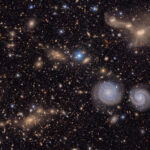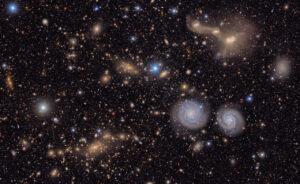
Ever-changing Universe revealed in first imagery from NSF–DOE Vera C. Rubin Observatory

Observatory’s view of the Virgo Cluster, offering a vivid glimpse of the variety in the cosmos. Visible are two prominent spiral galaxies, three merging galaxies, galaxy groups both near and distant, stars within our own Milky Way, and much more. Credit: NSF–DOE Vera C. Rubin Observatory
The NSF–DOE Vera C. Rubin Observatory, a major new scientific facility jointly funded by the U.S. National Science Foundation and the U.S. Department of Energy’s Office of Science, released its first imagery at an event in Washington, D.C. The imagery shows cosmic phenomena captured at an unprecedented scale. In just over 10 hours of test observations, NSF–DOE Rubin Observatory has already captured millions of galaxies and Milky Way stars and thousands of asteroids. The imagery is a small preview of Rubin Observatory’s upcoming 10-year scientific mission to explore and understand some of the Universe’s biggest mysteries.
The result of more than two decades of work, Rubin Observatory is perched at the summit of Cerro Pachón in Chile, where dry air and dark skies provide one of the world’s best observing locations. Rubin’s innovative 8.4-meter telescope has the largest digital camera ever built, which feeds a powerful data processing system. Later in 2025, Rubin will begin its primary mission, the Legacy Survey of Space and Time, in which it will ceaselessly scan the sky nightly for 10 years to precisely capture every visible change.
More information
- Vera C. Rubin Observatory website: https://rubinobservatory.org/news/first-imagery-rubin



